Definition of Intelligent Edge
What is Intelligent Edge? — Intelligent edge, is the concept that defines the added computation, storage, and communication capabilities of certain infrastructure located closer to the end-user, usually at a distributed network edge.
The word “edge” in this context represents the geographical proximity of where the data is being generated. In other words, the edge is the place where the “Things” of IoT are. This set of connected IoT devices are always close to the user and its data. At the edge, this data is processed with intelligence; it can get analyzed, aggregated, or addressed. The Intelligent edge uses edge computing to support these edge devices on analytics performed by AI and ML models.
The devices at the edge have the computational power and intelligence to handle different kinds of data which traditionally would have been sent to a central server in the cloud.
The intelligent edge breaks the traditional Client-Server model, where the client is usually “dumb or thin,” and the server is the one with the power to process, analyze data, and secure it. Although the intelligent edge might leverage from certain processing performed on the cloud or other remote data centers, it does not rely on a centralized power.
What is not an Intelligent Edge? — Intelligent Edge is not cloud computing. These two concepts are NOT interchangeable. Edge intelligence is preferred in remote locations where the connection is limited (or there is no connection) to a centralized location, and the data processing is time-sensitive. On the other hand, the cloud computing model relies entirely on a remote server, for storage, computations, security, etc.
A Brief History of Intelligent Edge
Intelligent edge (or edge computing) might be a new buzzword, but its underlying technology has been developing since decades ago.
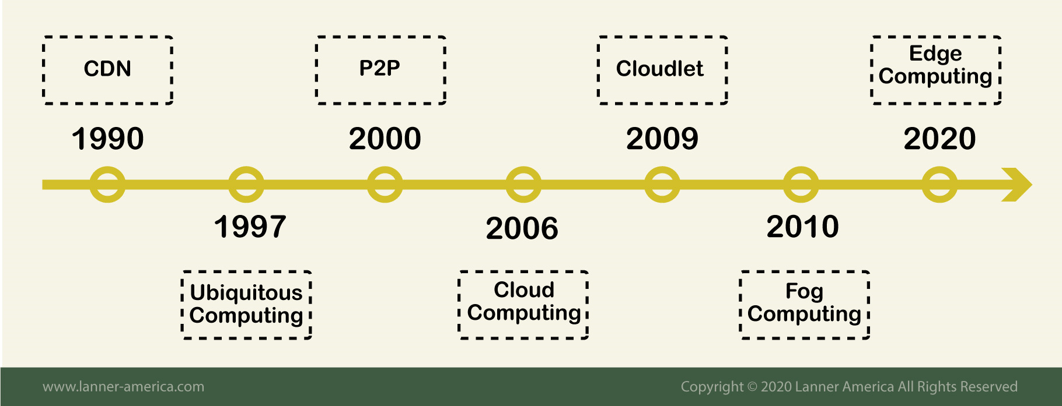
1990. Edge computing can be traced back to 1990, with the origin of the first Content Delivery Network (CDN), by Akamai. This network delivered cached images and videos using distributed servers located closer to the end-user. Thanks to CDNs websites began running much faster.
1997. Around 1997, the concept of Pervasive Computing (also known as Ubiquitous Computing) which is the technology behind IoT, started to appear. Its goal was to reduce the load on the computing resources and improve the battery life of mobile devices. It offloaded certain tasks of applications that consumed more resources to local servers.
In the early 2000s, the overlay Peer-to-Peer (P2P) networks brought the concept of proximity routing to avoid slow downloads over long-distance servers. In P2P, the members of a swarm (the network of peers) were able to locate other nearby members, and download content much faster.
In the mid-2000s, around 2006 the first public cloud computing started. Amazon’s Elastic Compute Cloud (EC2) was the first service that started renting computing and storage resources to end-users.
By 2009, the Cloudlet concept was coined by M. Satyanarayanan, Victor Bahl, Ramón Cáceres, and Nigel Davies, which is also known as “follow-me-cloud” or micro-cloud. The Cloudlet is a mobility-enhanced mini cloud data center located at the edge. Its goal is similar to previous applications, to support resource-intensive mobile applications.
In the early 2010, Cisco introduced the concept of Fog Computing, which is a distributed cloud that uses intelligent edge nodes to perform a large amount of computation, storage, and communication. Fog computing brings the processing power to Local Area Networks, closer to where the data is created.
Today, we are already in the edge computing era and slowly shifting into an intelligent edge. The fact that there is a massive amount of data being generated by IoT devices outside data centers, makes the intelligence to be close to end-users. Although we are still highly dependent on the central “cloud-based server” for certain workloads or computations, the best solution is to deploy a complementary strategy for cloud and edge.
Intelligent Edge: Range of Operations
The range of operations that the Intelligent Edge can provide can be defined through the three Cs: Connect, Compute, and Control.
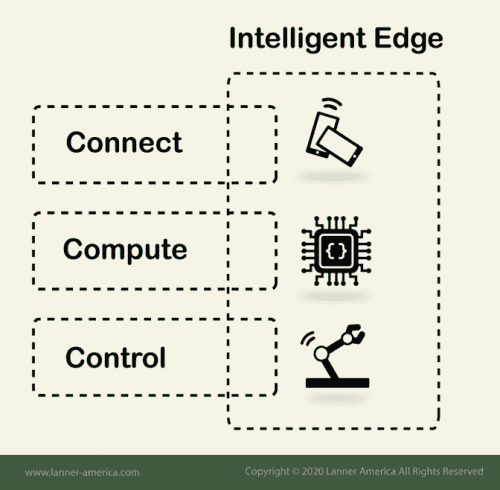
- Connect: The edge intelligence provides network connectivity to things, devices, and end-users at the edge. The systems can be linked together via wireless or wired connections. The intelligent edge improves the exchange of data and links everything together, from self-driving vehicles, smart tools, appliances, robots, smart houses, sensors, street lights, etc.
- Compute: All these connected intelligent edge systems can generate massive amounts of data and compute it locally. This local computing can help or even replace entirely the computing performed by cloud data centers. The computation provides data analysis, processing, and cognitive capabilities.
Today, almost all edge devices have built-in computing capacity that can pre-process the data in some way. But in most cases, the computing is performed by edge servers (or IoT Gateways) which are pieces of IT equipment built for the purpose of edge computing. These servers could be a half-rack, a couple of blades, or an industrial embedded PC.
- Control: The computed insights from these connected devices can then be used for certain business processes that require control. The intelligent edge can perform control mechanisms on these things and devices at the edge. For example, they can be re-configured through scripts, controlled through actuators, orchestrated, etc.
Types of Intelligent Edge
The intelligent edge can be categorized through three different types, the OT edge, IT edge, and the IoT edge which is a convergence of IT and OT.
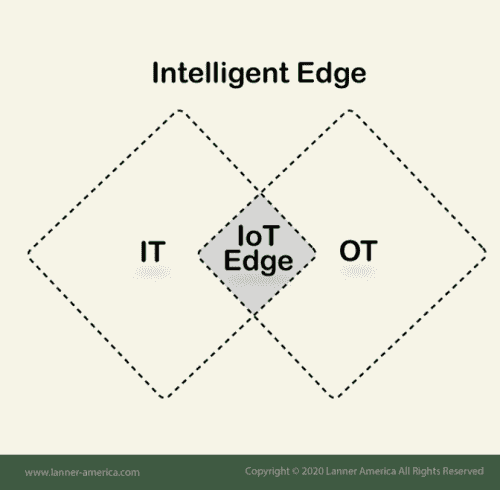
- Operational Technology (OT) Edge. The OT are usually devices or software built to detect or alter physical processes and are generally used in the industry. These OT systems reside on the edge and have the intelligence and controls but usually lack connectivity and computing power. Examples of OT edge intelligence are electrical subsystem stations, crop fields, city streets, offshore oil rigs, manufacturing plants, etc.
There is a new breed of OT edge devices that are coming with a more powerful connectivity and computing capacity. These OT edge intelligent devices are adopting some IT processes, they are also referred to as the Industrial Internet of Things (IIoT) devices. - The Information Technology (IT) Edge. The IT edge devices are usually more powerful in connectivity and computational power than OT devices. The IT edge takes the enterprise-grade IT power from the data center and pushes it out to the edge. Examples of the IT edge are distributed telecommunications, media industry, etc.
The new breed of the IT edge is often referred to as the Internet of Things (IoT). Traditional IT devices with connectivity to the Internet are now coming with sensors and actuators to get physical input and output from the external world. - The IoT Edge Networks. In most cases, an IoT Edge Network is the result of OT and IT domains converging. When IT goes outside of a data center, it can be integrated into different OT functions. The simplest example of this is the smartphone, which is an IoT device with radio + video camera + computing + Internet connectivity.
In the same case an OT device that adopts IT and opens up connectivity to the Internet (IIoT). An example is a Cobot (Collaborative Robot) which comes with actuators + sensors + cameras + computation.
How does Intelligent Edge work?
Intelligent edge IoT networks usually follow a four-step process:
- First, it senses or acts on data from the external world.
- Second, it uses an IoT Gateway to aggregate data.
- Third, all the aggregated data is sent to a pre-processing or analysis system
- Finally, it is sent to a data center or cloud for final processing.
The intelligent edge works through these four-step process following the three main components, the edge device, the edge server (IoT Gateway), and the cloud (or remote data center).
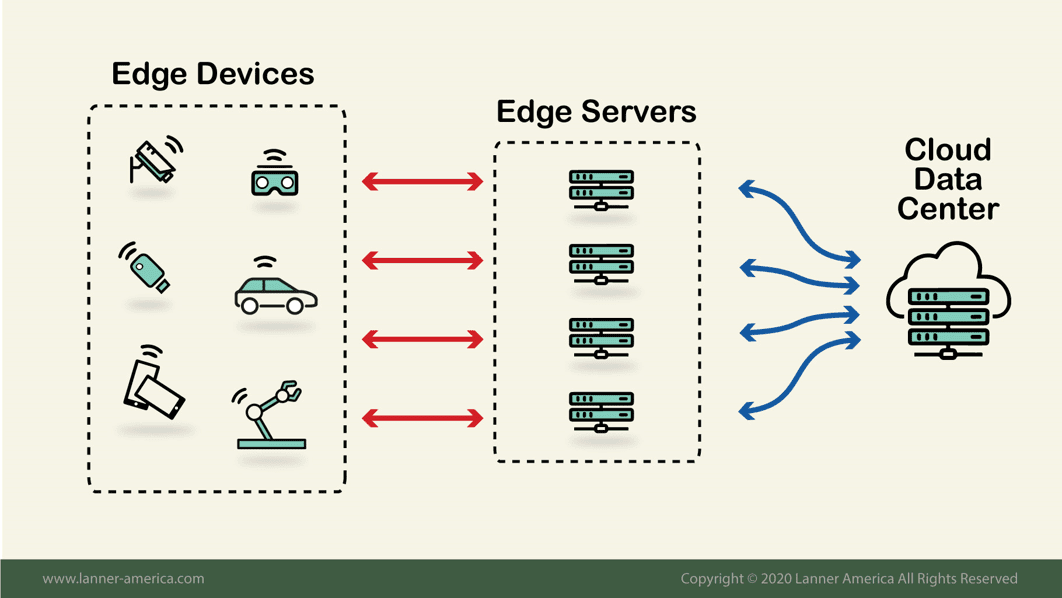
The edge device is the unit built with a purpose and with the computing capacity to fulfill that purpose. These devices are generally efficient at gathering data, pre-processing it, and then transmitting it through the network. Examples are an assembly line, a robot, an autonomous vehicle, a wind turbine, a water gauge, intelligent video cameras, VR/AR headsets, etc.
It is very common that some intelligent environments use edge servers. The purpose of these servers is to pre-process all data in near real-time and perform some processes such as orchestration, monitoring or just prepare the data for transmission to the cloud. These servers are also often used for data visualization, better analytics, data caching, buffering, streaming, data filtering, optimization, etc.
If the data needs further processing or storage, it can be sent to the cloud. The cloud complements the intelligent edge with capabilities such as further data processing, business logic, and data warehouses.
Why use Intelligent Edge?
Sending and receiving data, especially Big Data from a cloud-based server, takes time. In fact, public cloud services such as AWS offer solutions for this problem. Services such as the AWS Import/Export Disk ships you a portable storage device so you can load large amounts of data and ship the device back to AWS.
Cloud computing is an amazing solution, but it can be limited when it comes to mission-critical applications that need real-time data processing and have limited connectivity to the Internet. Bandwidth could temporarily make things faster, but it is not a scalable and cheap solution.
With the intelligent edge, instead of sending all the data out to a remote data center or cloud server for processing, some or all this data can stay close to where it was created. Not needing to move data, or big data for processing can help maximize business efficiency.
In a typical intelligent edge scenario, these nodes can bundle, analyze, refine, and encrypt the data before transmitting it into the data warehouse.
Some of the most important reasons why organizations are choosing to adopt Intelligent edge?
- To get closer proximity to the remote and mobile workforce.
- To process and apply cognitive computing to the data generated by IoT devices.
- To support new services and applications that require low latencies and high bandwidth.
- To complement the limitations of cloud computing.
The Main Benefits of Intelligent Edge
With the intelligent edge, businesses can be more self-contained and decentralized. Their data processing will no longer be interrupted by a faulty network or limited connectivity to the Internet. Being capable of pre-processing data before sending it out, these businesses will be able to reduce latency, enhance their safety transmission, improve bandwidth consumption, and lower costs.
What are the benefits of using Intelligent Edge?
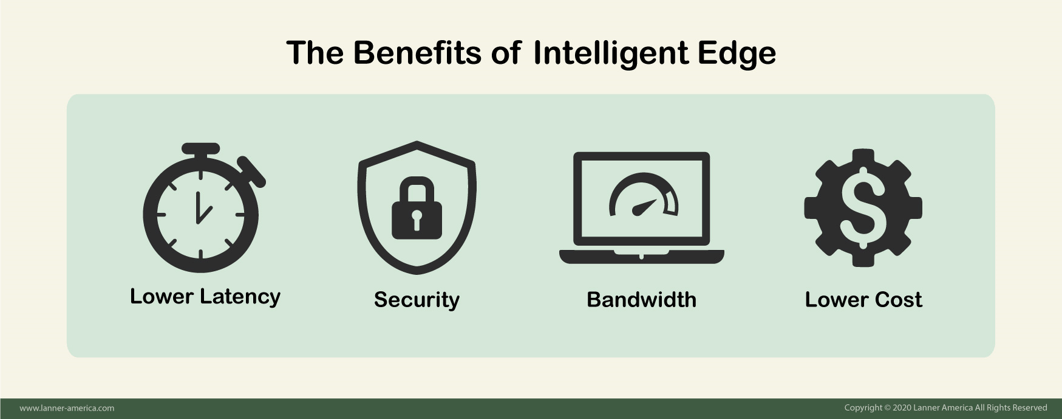
- Latency. One of the biggest benefits and drivers of why organizations are choosing to deploy edge computing, is that it reduces the latency. The idea of bringing computational power to the edge helps decrease data volumes, traffic, and the geographical distance that this data must travel.
- Security. On the edge, security is inherently improved. Since not all data needs to be transferred to a cloud-based server across the world, it is at a much lower risk of being compromised. Keeping data locally reduces the amount of sensitive data needing to be transmitted and stored in a remote server.
- Bandwidth. The intelligent edge can save lots of precious bandwidth by taking a heavy load off from the network. Since all processing of raw data is done by the edge devices, there is less data that needs to be transmitted to the cloud.
- Lower Cost. Bandwidth and storage are expensive resources. Keeping data processing locally, reduces the backhaul traffic volumes, geographical distances, and keeps data secure. Without a large demand for cloud storage and Internet bandwidth, the costs drop significantly.
Examples of Intelligent Edge
What are some applications of edge intelligence? — As mentioned above, the edge is where the action is taking place. It could be a power plant, a manufacturing floor, a self-driving vehicle, or even a smartphone. The edge is where the “Things” of the “IoT” are and where they are doing their computation.
Applications of edge intelligence can fall into different sectors within the industry, agriculture, and even military. The most popular use case and examples of applications of edge intelligence are:
- Manufacturing: Using the intelligence edge along Machine Learning (ML) or Artificial Intelligence (AI) algorithms can help to monitor and control manufacturing processes. For example, deploying IIoT devices along a conveyor belt, like robots, or cameras can help in the product development process.
- Smart Homes: The building and housing industry are increasingly integrating technology into its processes. The intelligence edge in smart homes can range from energy consumption management, HVAC control, smart thermostats, lighting systems, security, and more.
- Gaming Industry: The current network, computing, and storage infrastructure put many limitations on modern online video gaming. Video-gamers usually suffer from lag and delay while playing on a cloud-based game server. But by bringing the power closer to the end-user, the edge intelligence can make games respond faster. It can also bring new business opportunities like sophisticated mobile games, Virtual Reality, and Augmented Reality gaming.
- Connected Autonomous Vehicles: Autonomous vehicles rely on gathered data and heavy computing to perform quick decisions on the move. The built-in intelligent edge of vehicles such as cognitive mechanisms and fast data processing can make vehicles respond much faster. These vehicles can also use other IoT devices found in the external environment like other vehicles or the built-in ITS (Intelligent Transportation Systems) highways.
- Smart Cities: Cities are already using edge intelligence to keep data and its computing as close as possible to the source. Some examples of the intelligent edge in smart cities are traffic lights, video surveillance, sensor monitoring, ITS, etc.
- Telemedicine and the healthcare industry. IoT infrastructure with edge intelligence is playing an important role in healthcare. Patients are already using remote health monitoring devices such as insulin pumps or blood pressure monitors. Hospitals and healthcare facilities are also using the intelligent edge for processes like patient’s data analytics, predictive risk assessments, and healthcare equipment and apps.
The latency-sensitive applications such shown above would be inefficient relying entirely only on cloud computing. Intelligent Edge on the other hand, enables these applications to not suffer from high latencies and bandwidth bottlenecks.
The above is only a limited list of the potential applications of the intelligent edge. Basically, any term coined with the word “smart” will typically use a network of intelligent devices (IoT) that generate data at the edge and processes it on-premises.
Trends and Predictions of Intelligent Edge
Over the past few years, the intelligent edge has been consistently gaining importance. According to a report by Grand View Research, Inc, the global edge computing market is expected to reach $28.84 billion USD by 2025, with a Compound Annual Growth Rate (CAGR) of 54.0%.
Edge computing will bring new business models. Lots of vendors such as public cloud providers, Internet Service Providers (ISPs), Content Delivery Networks (CDN), or data center colocation providers have already started implementing intelligent edge to provide basic IaaS and PaaS services. The goal of most of these vendors is to decentralize connectivity to some of their services in order to support new and innovative businesses.
Edge computing and Cloud computing will coexist in harmony. According to Gartner, it is believed that by 2022 more than half of the enterprise-generated data will be created and processed outside data centers and cloud. The intelligent edge will certainly not replace cloud computing, in fact, both technologies will complement each other. In complex IoT environments that require a broad scope of requirements, a combination of both, also referred to as hybrid cloud will be the best solution.
The intelligent edge will handle IoT generated data and future AI and ML demands. Data centers or private clouds can transmit non-time-sensitive data with reliable connectivity to a public cloud to get cognitive computational processes such as AI and ML. But when it comes to IoT edge devices, they can generate massive amounts of information and their connectivity could be limited, so AI and ML must be done locally.
According to a survey from Forbes, organizations are looking towards the intelligent edge for two reasons. One, because of its potential to handle future AI and ML demands, and two, because of the fact that it can deliver services at ultra-low latencies.
Intelligent Edge Products
In order to get the most out of intelligence provided by AI and ML algorithms, we need data, loads of data. Although some IoT or IIoT edge devices with higher computational intelligence would be capable of running those cognitive algorithms, they still wouldn’t be able to handle a massive amount of data.
That is why we still need edge servers or fog nodes. These devices sitting between IoT edge and the cloud, are capable of pre-processing data, aggregating data, and even run AI and ML on data to gain insights.
Some Lanner’s edge server and radio modules products that could help to make intelligent use of AI at the edge:
- LEC-2290: An intelligent edge computing box PC, designed for GPU based and accelerated vision computing.
- LEC-3340: An industrial edge consolidation server, designed for Industrial Workload Consolidation and Control.
- LEC-6041: An Intelligent Edge Cyber Security Server designed to protect the communication in both IT and OT domains.
- V6S: A next-generation rugged edge vehicle surveillance NVR. V6S is designed for public transit video surveillance, recording and analytics.
- PGN-300: A 4G LTE Certified modem card compatible with Lanner Vehicle PC, Industrial PC and Network Appliances.
- PGN-600: A swappable 4G/LTE certified Module for Commercial, CBRS and FirstNet Networks.
Terminology
The subject of intelligent edge or edge computing can be defined with the help of other concepts. Below is a body of terms that can be used to broaden the knowledge on the subject. These terms are closely related to the intelligent edge.
- Cloudlet: This term was first coined by Satyanarayanan et al. A. Cloudlet is a small-scale data center (or mini-cloud) located at the edge of the network. The cloudlet has a similar purpose as the intelligent edge; It aims to bring the cloud computing capabilities closer to the end-user in order to support resource-intensive mobile applications.
- MicroData Center (MDC). An MDC is typically a small-scale containerized data center. MDCs are usually hosted in the Cloudlet. MDCs are distributed throughout different locations to provide lower latency to the edge of the network.
- Content Delivery Network (CDN). A CDN is a geographically distributed set of servers that aim to provide faster delivery of Internet content by using the concept of proximity. A CDN does not store the content, it only helps with processes such as caching, buffering, and streaming content at the network edge. CDNs can help reduce latency, bandwidth demands, and improve security.
- Fog Computing. This concept was developed by Cisco and it refers to the extension of cloud computing to the edge of a network. The fog network is located in the middle of the communication of the IoT devices and the cloud data center. It uses fog nodes to bring the computing, storage, and communication capabilities to the LAN. These fog nodes can be anything from switches, controllers, or routers.
- Mobile Edge Computing (MEC). MEC is also known as “Multi-Access Edge Computing,” and it is a standard architecture that aims to apply edge computing to mobile devices. MEC provides some of the traditional cloud computing capabilities and services right at the edge of a mobile network. MEC and 5G mobile broadband are known as the key driver for ultra-low latency mobile networks and high bandwidth.
- Ubiquitous Computing (UC), also known as Pervasive Computing, is the concept where the objects in the environment have computational capabilities and some sort of connectivity (not necessarily to the Internet). These UC objects can provide services based on context. An example of UC is the Wireless Sensor Networks (WSN) which are sensors with radio capabilities connected to each other.
- Internet of Things (IoT). Is a UC technology, where devices are capable of connecting to the Internet. Having access to the Internet can help IoT devices be monitored and controlled. Intelligence Edge was developed due to the exponential growth of the number of IoT devices and the data that they generate.
- Cognitive Computing (CC). This concept refers to a platform empowered with cognitive capabilities such as Artificial Intelligence, Machine Learning, Natural Language Processing, Speech Recognition, Deep Learning, Behavioral Recommendation, Risk Analysis, Trend Predictions, and more. The IoT networks that require any of these types of cognitive computing capabilities, can leverage from this intelligence at the edge, instead of the cloud.
Final Words
For the last couple of years, cloud computing has enabled the use of on-demand advanced analytics, Artificial Intelligence, and Machine Learning service models.
But as more and more data get generated at the edge by IoT and IIoT devices, it becomes nearly impossible to forward data and rely on cloud servers across the globe. AI and ML intelligence needs to move closer to the edge, where data gets generated.
We are starting to see the negative effects of relying completely on a cloud server. There are more data bottlenecks, bandwidth throttling, and worst of all vendor lock-ins. We need intelligent edge solutions that help us overcome those side effects of cloud computing.
An intelligent edge solution uses edge computing platforms to support IoT devices on analytics, AI, and ML models. While still the intelligent edge may use cloud computing, it does not rely 100% on it.
For more information, find out the new Intelligent Edge solutions launched by Lanner at the IoT Evolution Expo.
Sources
- The 3 M’s and 3 C’s of the Edge – Creating New Insights and New Business: https://www.cioapplications.com/cxoinsights/the-3-m-s-and-3-c-s-of-the-edge-creating-new-insights-and-new-business-nid-1019.html
- The Intelligent Edge: What it is, what it’s not, and why it’s useful: https://www.hpe.com/us/en/insights/articles/the-intelligent-edge-what-it-is-what-its-not-and-why-its-useful-1711.html
- Cloud and edge computing for IoT: a short history: https://blog.bosch-si.com/bosch-iot-suite/cloud-and-edge-computing-for-iot-a-short-history/
- Predictions 2020: Edge Computing Makes The Leap: https://www.forbes.com/sites/forrester/2019/12/02/predictions-2020-edge-computing-makes-the-leap/#5a85e19c4201
- 7 ways industries benefit from OT and IT Convergence: https://iiot-world.com/connected-industry/7-ways-industries-benefit-from-ot-and-it-convergence/